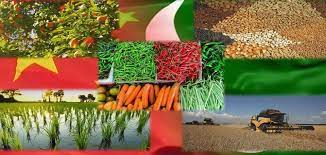F.P. Report
ISLAMABAD: As 2022 draws close, the agriculture sector has gained manifold tractions under China-Pakistan agriculture cooperation promising the phenomenal agri growth in the length and breadth of Pakistan, according to a report published by Gwadar Pro on Saturday.
Given the comprehensive spectrum of cooperation under “CPEC Green Corridor” throughout the year in 2022, the agriculture sector has recorded a remarkable growth of 4.4% and surpassed the target of 3.5% as well as last year’s growth of 3.48% during FY2022.
According to Economic Survey, the growth in the agriculture sector recorded 4.4% and surpassed the target of 3.5%.
This remarkable growth is mainly underpinned by China-led assistance to Pakistan of many facets relating transfer of hands-on experience in the fields of intercropping, high-yield seeds, pest control, hybrid cultivation, corporate farming, innovate irrigation technique, agri machinery training, agri research & development, protocol for Pak agri exports to China, digital farming and agri labor skills.
Since Sino-Pak agriculture has continued to deepen in 2022, Pakistan’s agricultural products exported to China from January to August 2022 reached $730 million with a year-on-year increase of 28.59%.
Pakistan’s agricultural exports to China are expected to exceed a record high of $1 billion next year.
On the back of 2022 agri sector’s milestone achievement, the focus of next year under CPEC Green Corridor will be continuing on improving land cultivation area, water management, better access to markets for inputs (seeds, fertilizers, farm mechanization, credit, water) and outputs, improved infrastructure including storage and cooling facilities, reduction in post-harvest losses, greater investment in research, development and extension, improved quality and fulfillment of quarantine requirements for international markets and competitiveness, greater diversification, especially minor but high-value crops, farm input and effectiveness of markets.
The announcement of three new corridors under CPEC including China-Pakistan Green Corridor (CPGC), which focuses on agricultural environment and food security speaks volumes about the significance of agricultural cooperation in CPEC.
The inauguration of the Intercropping Research Center jointly established by Sichuan Agricultural University (SAU) and the Islamia University of Bahawalpur (IUB) in 2021 showed fantastic results in the 2022 season.
According to a news report a few weeks ago, China’s maize-soybean strip intercropping technology completed harvest at 65 demonstration sites in Punjab, Sindh and Khyber Pakhtunkhwa recently, and the production of maize and soybeans reached 8,490 kg and 889 kg per hectare respectively in the intercropped fields.
Compared with the production of solely cropped maize and soybeans at these 65 sites which are 8,995 kg and 1,531 kg per hectare respectively, the intercropping technology definitely creates much more economic benefits.
Good news is that the researchers are also developing the strip intercropping systems of maize-peanut, maize-pea, sugarcane-soybean, sugarcane-mustard, wheat-mustard, wheat-soybean, wheat-chickpea, potato-maize and canola-pea.
Another healthy development in the agriculture sector happened in June, 2022 when a newly developed centre at Arid Agriculture University Rawalpindi (AAUR), the CPEC-Agriculture Cooperation Centre (ACC), announced to perform policy research, assist Chinese businesses in working in the agriculture sector, and foster institutional cooperation. Pakistan is also looking forward to enhance banana production with Chinese cooperation.
According to Nosherwan Haider, CEO of the Sprouts Biotech Laboratories, Pakistan contributes less than 0.5% to the global banana market whereas China contributes about 4.5%.
Cotton germplasm is another significant component in Pak-China agricultural cooperation. For many years, China and Pakistan have cooperated in the field of gathering and identifying cotton germplasm resources.
In order to determine which cotton germplasms are resistant to heat, drought, diseases, and insect pests in various locations and environments, Institute of Cotton Research (ICR) of the Chinese Academy of Agricultural Sciences (CAAS), collaborated with Cotton Research Institute (CRI), Multan, University of Agriculture Faisalabad (UAF), and some other universities and scientific research institutions.
During July, 2022, Tianjin Modern Vocational Technology College (TMVTC), China and MNS-University of Agriculture, Multan (MNSUAM), Pakistan signed an online agreement for an agricultural machinery training program of Luban Workshop in Pakistan.
The two institutions will jointly promote the sci-tech exchanges and cooperation on agricultural machinery, germplasm resources and agricultural environment.
Earlier this year, Zhang Jishu from Sichuan Litong Food Co., Ltd. announced that his company would implement a 1,000-acre pepper cultivation demonstration garden in Multan during the 2022-2023 growing season.
In partnership with local agribusinesses and farmers in Pakistan, it intends to take over 15,000 acres of pepper orders in South Punjab, with a planned harvest of 30,000 tonnes of dried pepper. Additionally, the company intends to construct two pepper processing plants in Lahore and Multan and is in the process of locating suitable sites.
Pakistan is also working to grow the sorghum crops as, along with the three main basic foods of the globe, sorghum is a crop that has increasingly gained acceptance around the world.
During the Symposium on Sorghum Industry Development of China and Pakistan organized during 2022, there was a consensus that, sorghum is a versatile crop that can be useful in supplying food and fodder.
Hybrid farming is growing in Pakistan in a variety of sectors, as the Executive Member of the Asia and Pacific Seed Association and General Manager of Wuhan Qingfa Hesheng Seed Company, Zhu Xiaobo said that the hybrid canola variety developed by her company has been planted in Pakistan on about 10,000 hectares of land, covering around 6000 households.
In the next three to five years, they expect it to expand to over 40,000 hectares and provide more and healthier edible oil to Pakistanis. Similarly Sino-Pak cooperation in cauliflower farming through hybrid seeds is also expanding.
As Pakistan faced one of the worst flood calamities in 2022, consequently loosing drastic crop yield, Wuhan-based hybrid seed developer and supplier China also announced to donate hybrid rice seeds to mitigate flood impact on agriculture and food security.
According to the Chairman of the Pakistan Agricultural Research Council (PARC), Dr. Ghulam Muhammad Ali, to raise the average productivity and output of Pakistan’s crops and to mitigate the harm caused by the floods, experts from Pakistan and China are developing hybrid wheat types.
To facilitate the swift development of agri-sector in the country, the Punjab cabinet approved the leasing out of state land for corporate farming as part of the CPEC initiative in the first week of March 2022.
The move, according to agriculturalists, would be a revolutionary one for Pakistan’s farming industry. Corporate farming describes the direct ownership or leasing of farmland by business organizations for the purpose of producing goods for their in-house processing needs or for the open market.
The Punjab Agriculture Department also made an effort to attract Chinese investment through the initiative by offering partnerships in organic farming, high-tech agricultural mechanization for both domestic and international markets, the development of precision and high-value agriculture, the development and production of seed technology, manufacturing of pesticides and fertilizer units along the CPEC route, and value-added processing facilities.
PARC and Yunnan Academy of Agricultural Sciences (YAAS) signed a MoU to promote agricultural cooperation between Pakistan and China at an online ceremony held in Beijing and Kunming during June 2022. YAAS specializes in the plant protection and pest control.
During recent times, food crisis was prevented in the country’s southern regions thanks to China’s thorough and prompt assistance in fighting locust swarms. To increase crop yield, climate resilience, water management, and aid in the fight against natural disasters like locust infestation, collaborations in precision agriculture and early warning systems should be further expanded.
Pakistan may be more interested in receiving assistance in climate-smart agriculture as China’s digital agro-economy is set to increase to over $100 billion. Incorporating cutting-edge information technology could therefore contribute to a third green revolution. (INP)







